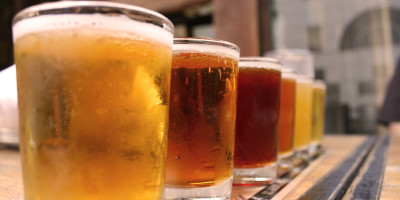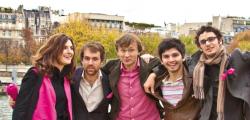
The St. Michael and St. Gudula Cathedral is located at the Treurenberg hill in Brussels, Belgium. Photo by William Murphy. Wikimedia Commons.
Top 10 Remarquable Facts about St. Michael and St. Gudula Cathedral
The Cathedral of St. Michael and St. Gudula, usually shortened to the Cathedral of St. Gudula or St. Gudula by locals, is a medieval Roman Catholic cathedral in central Brussels, Belgium.
It is dedicated to Saint Michael and Saint Gudula, the patron saints of the City of Brussels, and is considered to be one of the finest examples of Brabantine Gothic architecture. Let us look at the Top 10 Remarkable Facts about St. Michael and St. Gudula Cathedral.
1. It’s construction began in the 11th century

Exterior of the Cathedral of St. Michael and St. Gudula (Brussels). Photo by Cmcmcm1. Wikimedia Commons.
The Romanesque church’s construction began in the 11th century, replacing an earlier chapel, and was largely complete in its current Gothic form by the 16th. Its interior was frequently modified in the following centuries.
The building includes late-Gothic and Baroque chapels, whilst its neo-Gothic decorative elements, including some of its stained glass windows in the aisles, date from restoration work in the 19th century.
2. It can be traced back to a chapel dedicated to St. Michael
The cathedral’s origins are obscure, but historians agree that, as early as the 9th century, a chapel dedicated to Saint Michael probably stood in its place, on what was the most important point of Brussels at the time; the crossroads of two major trade routes—a first one connecting the County of Flanders and Cologne, and another between Antwerp and Mons, then France. These crossroads were located on the Treurenberg hill, where the St. Gudula Gate stood.
3. The cathedral was massively renovated in 16th and 17th century

Nave of the Cathedral of St. Michael and St. Gudula. Photo by Marek Śliwecki . Wikimedia Commons.
In the 16th and 17th centuries, the church underwent several modifications, the most remarkable of which was the addition of some chapels; the Chapel of the Blessed Sacrament of the Miracle (1534–1539), the Chapel of Our Lady of Deliverance (1649–1655) and the Chapel of St. Mary Magdalen (also called the Maes Chapel) (1672–1675).
4. It also undergone destruction several times
On 6 June 1579, the collegiate church was pillaged and wrecked by Protestant Geuzen (“Beggars”), and Saint Gudula’s relics were disinterred and scattered. In the 1790s, it also suffered looting and destruction by French revolutionaries known as the sans-culottes, including the loss of its original carillon.
5. It was elevated to a cathedral in 1962

Grenzing Organ in Cathedral of St. Michael and St. Gudula (Brussels). Photo by Cmcmcm1. Wikimedia Commons.
The church was elevated to cathedral status in 1962 and has since been the co-cathedral of the Metropolitan Archdiocese of Mechelen–Brussels, together with St. Rumbold’s Cathedral in Mechelen, Flemish Brabant.
As the national church of Belgium and the Primate of Belgium’s official seat, it frequently hosts royal weddings, state funerals and other official ceremonies, such as the Te Deum on Belgian National Day. For example, in 1999, it was the setting for the wedding of Prince Philippe and Mathilde d’Udekem d’Acoz.
6. The building is an example of brabantine gothic and baroque style
Most of the cathedral is in the Brabantine Gothic style, although some parts are in the newer Baroque style. The cathedral is built of stone from the Gobertange quarry, which is located in present-day Walloon Brabant, approximately 45 km (28 mi) south-east of the cathedral’s site.
The building adopts the classic plan: a Latin cross with a three-bay long choir ending in a five-sided apse surrounded by an ambulatory.[6] It is imposing by its sheer size: 110 metres (360 ft) long, 30 metres (98 ft) wide (50 metres (160 ft) at the level of the choir), and 26.5 metres (87 ft) high (the entrance towers reach a height of 69 metres (226 ft)).
7. It has stained glasses from the 16th, 17th and 19th centuries

Grenzing Organ in Cathedral of St. Michael and St. Gudula (Brussels). Photo by Cmcmcm1. Wikimedia Commons.
The cathedral has stained glass windows from the 16th, 17th and 19th centuries; most of which date from between 1525 and 1663. Particularly noteworthy is the large window in the western façade representing the Last Judgement.
It was made in 1528 by the Antwerp glassmaker Jan Haeck, based on drawings by Bernard van Orley. Haeck and Van Orley were also responsible for the windows adorning the northern and southern transepts.
8. The cathedral has a huge organ pipe
The large pipe organ in the nave was inaugurated in October 2000. It hangs as a swallow’s nest organ at the level of the triforium, and has a total of 4300 pipes, 63 stops, 4 keyboards and the pedal-board.
This instrument is the work of the German organ-builder Gerhard Grenzing, based in Barcelona, in collaboration with the English architect Simon Platt. The two-manual choir organ was created in 1977 in the workshop of the organ-builder Patrick Collon.
9. Both towers at the cathedral have bells
Both towers contain bells. The south tower contains a 49-bell carillon from 1966 by the Royal Eijsbouts bell foundry, on which Sunday concerts are often given. Out of all the bells in the carillon, only seven of them can ring.
They are, from heaviest to lightest: Fabiola, Maria, Michael, Gudula, Philippe, Astrid, and Laurent. Fabiola, Philippe, Astrid and Laurent are named after members of the Belgian Royal Family. The north tower contains a single bourdon called Salvator, it was cast by Peter van den Gheyn in 1638.
10. There are falcons at the cathedral

St. Michael & St. Gudula Cathedral Tower, Brussels, Belgium. Photo by Donaldytong. Wikimedia Commons.
At the end of the 1990s, Brussels ornithologists discovered a couple of peregrine falcons hibernating on top of the cathedral’s towers. In 2001, ornithologists of the Royal Belgian Institute of Natural Sciences (RBINS) in association with the Fonds d’Intervention pour les Rapaces (FIR); a French association dedicated to the protection of raptors, installed a laying-nest on the edifice in an attempt to encourage nest-building.
This laying-nest was never used, but in the spring of 2004, a pair of falcons nested on a balcony on top of the cathedral’s northern tower. At the beginning of March, the female laid three eggs.
As a result of watching the three chicks perform acrobatic feats on the cathedral’s gargoyles, at the end of May 2004, the project “Falcons for everyone” was developed by the RBINS in association with the Commission Ornithologique de Watermael-Boitsfort. The project installed cameras with a live video stream on their website.

 English
English











